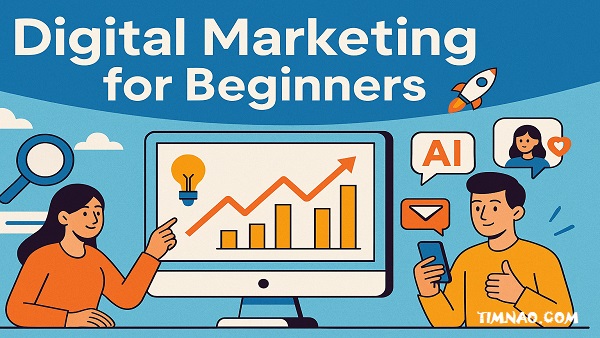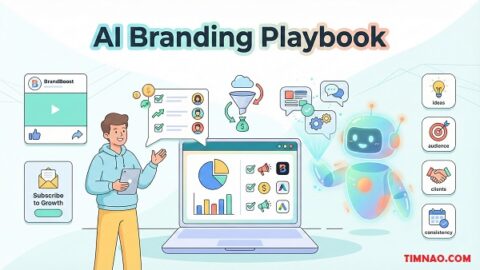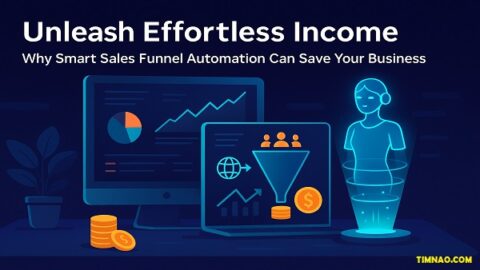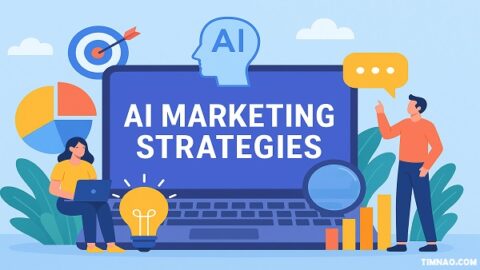Why Most Small Businesses Fail at Digital Marketing — And How You Can Win Big 💡
Digital marketing for beginners can feel overwhelming — like you need to be everywhere, know everything, and spend thousands just to get noticed.
The good news? That’s a myth.
In reality, digital marketing is one of the most accessible and high-impact ways to grow your small business — even if you’re just starting out. You don’t need to be an expert. You just need a strategy that works and a roadmap you can actually follow.
Whether you’re a shop owner, a service provider, a solopreneur, or launching your first side hustle, this beginner’s guide will show you how to:
-
Get found online (even by total strangers)
-
Build trust and engagement with your audience
-
Use tools like SEO, social media, and AI to save time and money
-
Turn followers into loyal customers who come back again and again
You don’t need a marketing degree or a big budget. You just need the right steps — and that’s exactly what you’ll get here.
Ready to simplify your strategy, grow your brand, and finally feel confident about marketing online?
Let’s jump into the ultimate guide to digital marketing for beginners. 🚀
📚 Table of Contents
- 🎯 Why Digital Marketing Still Matters in 2025
- 🧩 Your Audience Is the Starting Point — Here’s Why
- 🧠 Set Smarter Goals, Not Just More Goals
- 📊 Mastering Metrics Without Getting Lost
- 🌐 Build a Presence That’s Impossible to Ignore
- 🔍 Unlock the Power of SEO for Beginners
- 🤖 AI Tools That Make Marketing Easier Than Ever
- 📣 Influencer Marketing Tips for Beginners
- 📱 Social Media Marketing for Beginners
- 💌 Content & Email Marketing That Converts
- 📈 Track, Analyze, and Keep Growing
🎯 Why Digital Marketing Still Matters in 2025
In 2025, digital marketing isn’t just a trend — it’s survival. Whether you’re running a corner bakery, a local bookstore, or an online store, your customers are online. And if they can’t find you there, they’ll find your competitors.
Many small business owners still rely heavily on word-of-mouth or hope their website “just works.” But the reality is, without a clear digital strategy, you’re leaving money (and growth) on the table.
So what is digital marketing, really?
At its core, digital marketing is everything you do online to get noticed, build trust, and drive sales. That includes:
- Showing up in Google search results (thanks, SEO!)
- Posting engaging content on Instagram or TikTok
- Using AI tools to create content faster
- Collaborating with influencers in your niche
- Running email campaigns that actually get opened
Here’s the good news: You don’t need a degree in marketing to make it work. What you need is a structured, smart approach. And that’s what this article delivers — clear, actionable strategies designed for real people, not marketing experts.
We’ll walk you through the basics, show you modern tools, and help you avoid common traps. No jargon. No fluff. Just what works.
🧩 Your Audience Is the Starting Point — Here’s Why
Before you launch an ad, write a blog, or post a single TikTok, ask this:
Who am I trying to reach?
Many small business owners guess — and guess wrong. You might think your audience is “everyone who likes coffee” or “people who want to get fit,” but that’s way too broad.
Start with research:
- Use Google Analytics to see who’s already visiting your site.
- Dive into Instagram/Facebook insights to check age, location, and activity.
- Survey your top customers — why did they choose you?
Then, build a customer persona — a simple profile of your ideal customer. Include things like:
- Age & gender
- Job & income level
- What problems they have
- Where they spend time online
- What content or brands they already follow
If you run a boutique gym, your persona might be:
“Tina, 33, a busy mom who wants 30-minute workouts that fit her schedule and make her feel confident. She uses Instagram, reads wellness blogs, and hates aggressive sales tactics.”
Once you know who you’re talking to, everything else — content, ads, partnerships — becomes 10x easier and more effective.
🧠 Set Smarter Goals, Not Just More Goals
One of the biggest mistakes in digital marketing? Doing a bunch of stuff without knowing why.
That’s where SMART goals come in:
- Specific: What exactly do you want?
- Measurable: How will you track it?
- Achievable: Is it realistic?
- Relevant: Does it help your business?
- Time-bound: When will it be done?
Example:
❌ “I want more website visitors.”
✅ “Increase monthly website traffic by 25% in 3 months by publishing 2 blog posts weekly and promoting them on Pinterest.”
Other good digital marketing goals include:
- Grow email subscribers by 500 in 90 days
- Hit 1,000 Instagram followers by running giveaways
- Increase online sales by 20% through retargeting ads
Goals give you focus. Focus gives you results.
📊 Mastering Metrics Without Getting Lost
Digital marketing is data-driven — but not all data is helpful.
Here are the 5 metrics beginners should actually track:
- Traffic – How many people visit your site?
- Conversion Rate – What % of them take action (buy, sign up, book)?
- Bounce Rate – How many leave after just one page?
- Engagement – Likes, comments, shares on social posts
- ROI – Are your campaigns profitable?
Use free tools like Google Analytics and Meta Business Suite to keep tabs on performance.
Pro tip: Don’t just measure — interpret. If your email open rates are low, maybe your subject lines need work. If your bounce rate is high, maybe your website is confusing.
Tracking is only powerful if it leads to action.
🌐 Build a Presence That’s Impossible to Ignore
Your online presence is your modern storefront. If it’s slow, clunky, or confusing — customers will walk away.
Here’s what you need:
✅ A Simple, Fast Website
- Mobile-optimized (at least 60% of visitors are on phones)
- Easy to navigate
- Includes contact info, services, and trust signals (reviews, testimonials)
Use platforms like Wix, Squarespace, or WordPress for easy setup.
✅ Active Social Profiles
Don’t try to be everywhere. Start with 1–2 platforms your audience loves. For most small businesses, that’s Instagram and Facebook — or TikTok if you’re targeting Gen Z.
Post consistently. Use behind-the-scenes content, product demos, testimonials, or short-form videos to boost engagement.
✅ Reputation Management
- Ask happy customers for reviews (Google, Yelp, Facebook)
- Respond to every comment — even the angry ones
- Set Google Alerts for your business name
If your brand is invisible online, your business might as well not exist. Harsh, but true.
🔍 Unlock the Power of SEO for Beginners
Search Engine Optimization (SEO) sounds intimidating — like something only tech wizards or massive corporations can use. But guess what? It’s one of the most beginner-friendly, ROI-positive tools out there.
SEO is simply the art (and science) of helping your ideal customer find you on Google — for free.
If someone types “best pizza in Austin” and your restaurant shows up first, that’s SEO magic. And you can do it, even without technical know-how.
🧠 Step 1: Keyword Research That Makes Sense
Start by thinking like your customer. What would they type into Google to find your product?
Example:
If you sell eco-friendly yoga mats, keywords might be:
- “non-toxic yoga mat”
- “eco yoga mat for beginners”
- “best yoga mat for home workouts”
Use tools like:
- Google Keyword Planner (free)
- Ubersuggest (freemium)
- AnswerThePublic (great for blog topics)
Focus on long-tail keywords — specific, less competitive phrases that match buyer intent. These often convert better and are easier to rank for.
🛠️ Step 2: Make Your Website Google-Friendly
This is called “on-page SEO,” and it’s all about tweaking your website content and structure.
Here’s your simple checklist:
- ✅ Title Tags: Use your main keyword near the beginning.
Example: “Best Eco Yoga Mats for Home Workouts – EarthFlow” - ✅ Meta Descriptions: Write a compelling 150-character summary.
Example: “Shop EarthFlow’s eco-friendly yoga mats — perfect for home workouts & sustainability lovers.” - ✅ Headers (H1, H2, etc.): Break up content using headings with keywords where they fit naturally.
- ✅ Image Alt Text: Rename your images from “IMG122.jpg” to “green-yoga-mat.jpg” and describe them in the alt tags.
- ✅ Internal Linking: Link blog posts to product pages or related services.
- ✅ Speed & Mobile: Use tools like GTMetrix or PageSpeed Insights to test speed and mobile-friendliness.
Google rewards helpful, well-structured pages. If your site is a mess, even amazing products won’t rank.
🔗 Step 3: Get Other Sites to Talk About You
This is “off-page SEO,” and it’s how Google figures out whether others trust you.
💡 Pro tip: Google trusts websites that other trusted websites link to.
How to earn backlinks:
- Write a guest post for a local business blog
- Partner with bloggers in your niche (see Influencer section)
- Get listed in online directories (Yelp, TripAdvisor, Chamber of Commerce)
- Create awesome content that others want to share (infographics, videos, how-to guides)
And don’t forget local SEO:
- Set up Google Business Profile
- Use local keywords like “bakery in Boise” or “best plumber near Times Square”
- Ask customers to leave Google reviews (and respond to them!)
📈 Track Your SEO Progress
Use Google Search Console to see:
- What keywords bring people to your site
- Which pages get clicked the most
- What issues Google finds on your site
SEO takes time — usually 3–6 months to see results — but the payoff is huge: free traffic that keeps coming.
🤖 AI Tools That Make Marketing Easier Than Ever
You’ve heard the buzz: AI is taking over. But it’s not just for tech giants — it’s actually the small business owner’s secret weapon.
Imagine:
- Chatbots answering FAQs 24/7
- Emails written in seconds
- Social posts auto-scheduled and optimized
- Predictive analytics showing who’s about to buy
AI saves time, improves accuracy, and personalizes customer experience. Let’s break it down.
🧠 Use AI to Automate the Repetitive Stuff
Tired of writing product descriptions or email intros?
Use tools like:
- Jasper or Copy.ai — for writing blogs, captions, and product copy
- Grammarly — for writing that sounds professional
- SurferSEO — for optimizing articles for Google
- Canva Magic Write — AI text + design combo
Need help with chat support?
Try Tidio or ManyChat to set up AI-powered chatbots that answer common questions and route leads.
🔮 Use AI to Predict What Customers Will Do Next
With tools like:
…you can predict customer behavior. Like who’s about to churn. Or what product someone’s most likely to buy next.
That means better email targeting, better upsells, and higher customer retention.
🎯 AI for Personalizing Campaigns
People crave personalization. With AI, you can deliver it at scale.
Ways to personalize:
- Emails with product suggestions based on browsing history
- Dynamic landing pages showing different products to different visitors
- Automated cart abandonment messages
Use tools like Klaviyo or MailerLite to send tailored emails triggered by behavior.
💡 Example:
A skincare brand uses AI to analyze which products a user clicked. Next day, that user receives an email:
“Still curious about our anti-aging set? Here’s 10% off.”
That’s AI-driven magic.
📣 Influencer Marketing Tips for Beginners
Gone are the days when you needed to hire a Kardashian to see results.
Today, micro-influencers (10k–50k followers) and nano-influencers (under 10k) are winning big — especially for small brands.
Their followers are engaged. They trust the influencer. And their fees are affordable.
🤝 Step 1: Find the Right Influencer
Use tools like:
Look for creators in your niche with good engagement (3–10% is strong) and audience alignment.
Example:
If you sell vegan desserts, look for plant-based food bloggers or fitness coaches.
Don’t obsess over vanity metrics. A smaller, engaged audience beats a huge, passive one.
✍️ Step 2: Pitch with Value
DM or email with:
- What you like about their work
- What you offer (free product, cash, affiliate %)
- Why you’re a good match
- What type of content you’re hoping for (a reel, story, review, etc.)
Example message:
“Hi Sarah! I loved your recent post about low-sugar recipes. I run a startup that makes vegan cookie kits. I think your followers would love it. Can I send you a box to try? I’d love to collaborate on a story or recipe reel!”
🎥 Step 3: Let Them Create — And Track Results
Give them guidelines, but don’t script it. Authenticity wins.
Ask them to tag your account, use a campaign hashtag, and share a story + feed post if possible.
Use tracking links (from Bitly or your email software) to monitor traffic and conversions.
Track:
- Engagement (likes, comments, shares)
- Follower growth
- Website traffic from the post
- Sales or sign-ups using their code/link
Bonus Tip: Repost their content across your own social media and ads. It doubles the ROI.
📱 Social Media Marketing for Beginners
It’s 2025 — if your business isn’t on social media, you’re invisible to a massive chunk of your market. But it’s not enough to just “be present.” You have to be strategic.
Social media isn’t about broadcasting. It’s about connecting.
Here’s how to turn scrolls into sales:
🔄 Be Platform-Specific
Don’t copy-paste the same post across platforms. Each one has its own vibe.
- Instagram: Visual-first. Use Reels, Stories, and carousel posts.
- TikTok: Great for short, fun videos — especially for Gen Z & Millennials.
- Facebook: Still strong for local businesses, community-building, and older audiences.
- Pinterest: Excellent for products, DIY, fashion, and “how-to” content.
- LinkedIn: Best for B2B and professional services.
Start with just 1–2 platforms where your target audience spends the most time.
📅 Post with Purpose (Not Just Frequency)
What should you post? Mix it up:
- Behind-the-scenes: Show how you make your product or prep your service.
- Customer stories: Real testimonials build trust.
- Quick tips: Educate without selling.
- Before-and-after shots: Perfect for beauty, fitness, food, home, and design.
- Mini tutorials: Teach something useful in 30–60 seconds.
- Polls & Q&As: Boost engagement via Stories and captions.
Use a simple content calendar (e.g., Trello, Notion, or Later) to stay consistent.
📊 Track & Tweak
Look beyond likes. Focus on:
- Saves & shares (real indicators of value)
- Story replies (means they’re paying attention)
- Website taps / link clicks (where the sales start)
Use built-in tools like Instagram Insights, Facebook Page Analytics, or TikTok Business Dashboard to monitor and adjust your content strategy.
💌 Content & Email Marketing That Converts
Social media is great for grabbing attention. But content marketing and email are what build loyalty and drive conversions over time.
Here’s how to use both — even if you’re not a “writer.”
📝 Blogging Isn’t Dead — It Just Needs Strategy
A blog can boost SEO, show your expertise, and give value to potential buyers. It’s perfect for small businesses.
Great blog ideas:
- “5 Mistakes to Avoid When…”
- “How We Helped [X Customer] Go From ___ to ___”
- “The Beginner’s Guide to [Your Product Category]”
- “What Nobody Tells You About [Your Niche]”
Post just 2–4 times a month. Use the keywords you researched in your SEO strategy. Link internally to your products or services.
💡 Use AI tools like SurferSEO or Frase to optimize content even if you’re a non-writer.
📩 Emails That Don’t Annoy (or Get Ignored)
Email isn’t old-school. It’s profitable. For every $1 you spend on email marketing, you can earn up to $42.
Start building your list today by offering:
- A 10% discount
- A free resource (e.g., guide, checklist)
- Early access to sales or new products
Then send valuable emails, not just promotions. Try:
- Weekly tips
- Product how-tos
- Seasonal updates
- Customer stories
- Birthday/anniversary offers
Use tools like ConvertKit, Mailchimp, or MailerLite — all beginner-friendly.
Segment your list by interest or behavior. This way, you don’t send the same thing to everyone. Your emails feel personal, timely, and useful.
📈 Track, Analyze, and Keep Growing
Even the best digital marketing strategies need refinement. What works now might not work next month.
This is where analytics comes in. Not just for data nerds — for any business owner who wants to grow smart.
📊 Tools to Use
- Google Analytics — See where traffic comes from, what pages people visit, and how long they stay.
- Google Search Console — Know which search terms lead to your site.
- Facebook & Instagram Insights — Analyze post performance and audience behavior.
- Email software reports — Check open rates, click-throughs, and unsubscribes.
- Heatmaps (like Hotjar) — Visualize how visitors move through your website.
🔄 What to Watch Weekly or Monthly
- Traffic growth: Is your audience expanding?
- Conversion rate: Are visitors becoming customers?
- Bounce rate: Are people leaving too fast?
- Top pages & posts: What content keeps people engaged?
- Sales sources: Where are customers coming from?
⚙️ Make Data-Driven Tweaks
If something’s working — double down.
If something’s failing — adjust the headline, image, or CTA. Test different strategies using A/B testing tools in your email or ad software.
💡 Example: You run a campaign for your online course. Version A has a video at the top. Version B starts with testimonials. See which performs better, then apply the learning sitewide.
🚀 Final Thoughts: You’re Closer Than You Think
Digital marketing doesn’t require a degree. You don’t need to go viral or outspend your competitors.
You just need:
- A clear goal
- A smart strategy
- The right tools
- And the consistency to keep going
Start simple. Launch one campaign. Write one post. Send one email. Use the tips and tools above to measure what happens. Improve. Repeat.
This is how real businesses win — not with magic, but with momentum.
✅ Quick Recap: 7 Must-Know Strategies for Small Business Digital Success
- 🎯 Know your audience deeply
- 📈 Set SMART goals you can measure
- 🔍 Use beginner-friendly SEO tactics
- 🤖 Let AI save you time and money
- 📣 Work with micro-influencers for real ROI
- 📝 Mix content, social, and email for reach + loyalty
- 📊 Track everything and adjust with confidence
🌐 Ready to take action?
Start applying 1 strategy from each section today. Bookmark this guide. Share it with your team. Or better yet, print it out and put it next to your laptop.
The sooner you start, the faster you’ll grow.
Reference video:










Please, continue to provide these insightful posts! Your content is consistently of the absolute highest quality, always offering fresh perspectives and truly valuable information. It’s a genuine pleasure to read everything you publish.